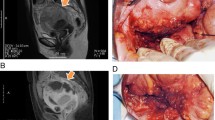Abstract
Angioma serpiginosum is a disorder of dilated superficial dermal capillaries. The disease is considered by some authors to be a consequence of increasing levels of estrogens. We present a case of angioma serpiginosum in a 46-year-old White woman. The lesions consisting of red-purple puncta were grouped as vaguely annular and angular patches with serpiginous borders, located on the right side of the neck, the right side of the abdomen, and on the left arm. Histopathologic examination revealed clusters of dilated capillaries in the dermal papillae, without endothelial proliferation. Periodic acid-Schiff (PAS) stain-positive deposits were noted around the affected blood vessels. However, immunohistochemical analysis revealed the absence of estrogen and progesterone receptors within the involved blood vessels. Hormonal assays were also normal. Our observations suggest that a hormonal stimulus probably plays no role in the pathogenesis of angioma serpiginosum. The significance of PAS-positive deposits as a diagnostic marker for angioma serpiginosum needs further confirmation.




Similar content being viewed by others
References
Cox NH, Paterson WD. Angioma serpiginosum: a simulator of purpura. Postgrad Med 11991; 67: 1065-6
Long CC, Lanigan SW. Treatment of angioma serpiginosum using a pulsed tunable dye laser. Br J Dermatol 1997; 136: 631-2
Michalowski R, Urban J. Atypical angioma serpiginosum: a case report. Dermatologica 1982; 164: 331-7
Stevenson JR, Lincoln Jr CS. Angioma serpiginosum. Arch Dermatol 1967; 95: 16-22
Katta R, Wagner A. Angioma serpiginosum with extensive cutaneous involvement. J Am Acad Dermatol 2000; 42: 384-5
Dowd PM, Champion RH. Disorders of blood vessels. In: Champion RH, Burton JL, Burns DA, et al., editors. Textbook of dermatology. 6th ed. Oxford: Blackwell Scientific Publications, 1998: 2092-7
Namazi MR, Handjani F. Angioma serpiginosum. Dermatol Online 12003; 9 (3): 19
Barker LP, Sachs PM. Angioma serpiginosum, a comparative study. Arch Dermatol 1965; 92: 613-20
Marriott PJ, Munro DD, Ryan T. Angioma serpiginosum-familial incidence. Br J Dermatol 1975; 93: 701-6
Al Hawsawi K, Al Aboud K, Al Aboud D, et al. Linear angioma serpiginosum. Pediatr Dermatol 2003; 20: 167-8
Neumann E. Some new observations on the genesis of angioma serpiginosum. Acta Derm Venereol 1971; 51: 194-8
Erbagci Z, Erbagci I, Erkilic S, et al. Angioma serpiginosum with retinal involvement in a male: a possible aetiological role of continuous cold exposure. J Eur Acad Dermatol Venereol 2004; 18: 238-9
Gerbig AW, Zala L, Hunziker T. Angioma serpiginosum, a skin change along Blaschko lines? Hautarzt 1995; 46: 847-9
Ohnishi T, Nagayama T, Morita T, et al. Angioma serpiginosum: a report of 2 cases identified using epiluminescence microscopy. Arch Dermatol 1999; 135: 1366-8
Gautier-Smith PC, Sanders MD, Sanderson KV. Ocular and nervous system involvement in angioma serpiginosum. Br J Ophthalmol 1971; 55: 433-43 16. Kumakiri M, Katoh N, Miura Y. Angioma serpiginosum. J Cutan Pathol 1980; 7: 410-21
Kumakiri M, Katoh N, Miura Y. Angioma serpiginosum. J Cutan Pathol 1980; 7: 410–21
Acknowledgments
No sources of funding were used to assist in the preparation of this case report. The authors have no conflicts of interest that are directly relevant to the content of the report.
Author information
Authors and Affiliations
Corresponding author
Rights and permissions
About this article
Cite this article
Erkek, E., Bozdogan, Ö., Akarsu, C. et al. Absence of Estrogen and Progesterone Receptors Around the Affected Vessels of Angioma Serpiginosum. Am J Clin Dermatol 7, 383–386 (2006). https://doi.org/10.2165/00128071-200607060-00007
Published:
Issue Date:
DOI: https://doi.org/10.2165/00128071-200607060-00007




